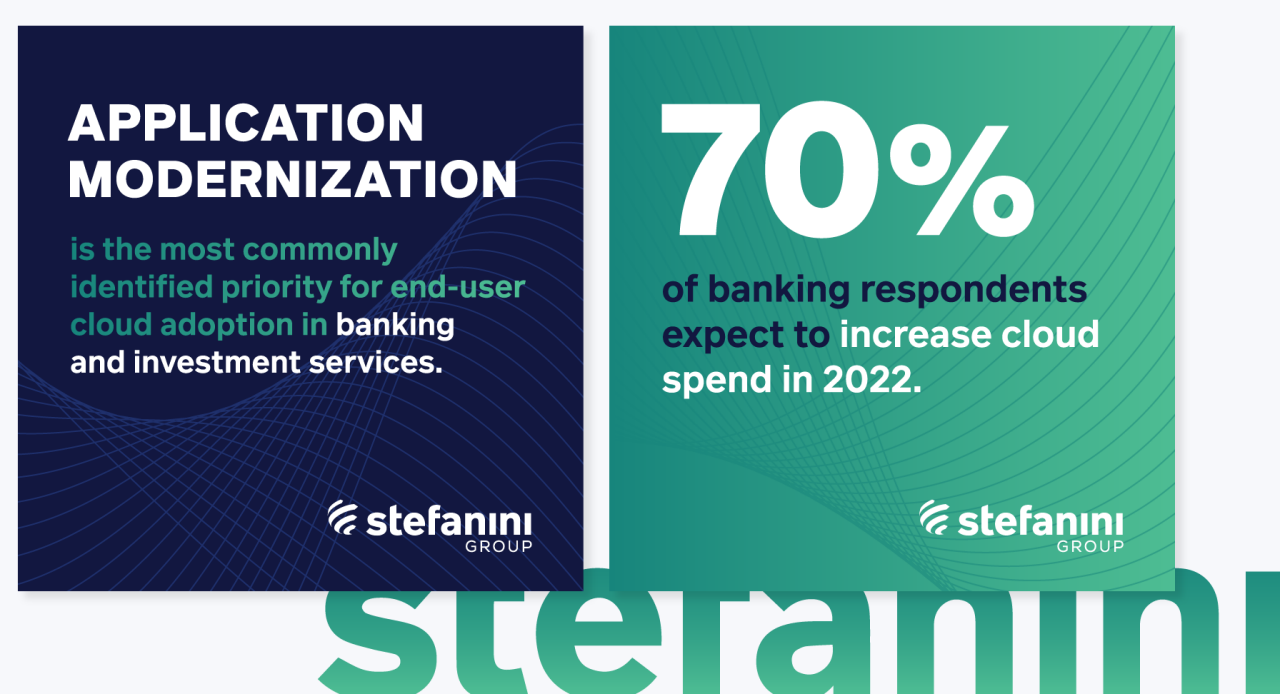The banking and financial services industry is facing massive pressure to fall into line with other global industries by moving to the cloud – as quickly as possible.
The banking sector is experiencing rapidly changing customer expectations along with emerging technologies and alternative business models, so they’re scrambling to put strategies in place to prepare for a new and very different future.
Cloud computing is moving to the forefront as a primary focus for banking and capital markets leaders as it becomes clear the cloud is not just a technology – it’s a destination.
The bottom line for banks and financial institutions (FIs) is that they need to deliver greatly improved customer experiences in real time, at a lower cost. The only way they can do this is to deploy modern technology, and until they modernize their infrastructures, they’ll be unable to keep pace with competitors who are already running with the ball.

Image source: Stefanini Group
How the cloud will benefit banks and FIs
Cloud computing offers a number of organizational and operational benefits for the financial industry and can dramatically transform an enterprise through improved business performance and shareholder returns. As well as increased security, faster processing speeds and lower costs, the benefits of cloud transformation can be broken down into two categories:
- Operational benefits
- Organizational benefits
Operational benefits
By leveraging the cloud in three basic areas, banks and FIs can create new operational business frontiers.
Synchronization
- They can achieve better integration of business units through the sharing of data. This can drive unified decision making, and faster resolution of customer problems.
- They can create common, connected data sets which will enable deeper, more intelligent insights and analytics.
- Through new shared platforms and tools, collaboration will be enhanced, increasing the speed of decisions.
Business innovation
- The cloud can help innovation and drive strategy to build new customer experiences.
- They can create new marketing offers, manage talent and optimize operations through AI and machine learning, IoT platforms, augmented and virtual reality, image recognition, natural language processing etc.
- Leveraging new tools and capabilities can increase revenue, cut costs, make operations more consistent and retain personnel more effectively.
Introducing new talent and ways of working
- By aligning tech with business needs, they can attract new talent and provide access to ecosystems with new skill sets.
- They can enable process improvements like automation or human augmentation to improve productivity and create integration, resulting in agility, connectedness and transparency.
Organizational benefits
Banks can also leverage the cloud to optimize in three key organizational areas to keep pace with competition.
Building resilience
- The cloud can enable them to build overall resilience through the ability to respond more quickly to things like physical outages and disruptions.
- By utilizing the cloud to move from on-premise data centers, they gain the ability to easily replicate data and app services across multiple data centers or regions.
Enhancing IT security
- Cloud providers take security very seriously, and correctly implemented, environments can be more secure than on-premises.
Scaling computing costs as needed
- The cloud can streamline the way they pay for tech changes. Instead of heavy up-front capital costs, spending can be scaled as needed.
- The cloud provides the ability to respond more quickly to market fluctuations or changes in financial priorities.
- FIs can capture cost efficiencies in dynamic cloud pricing by increasing or decreasing computing capacity as needed, facilitating better spending control.
The hesitation to move to the cloud
Banks and FIs have been hesitant to move to the cloud until now. Those accustomed to an on-premise data center may find the prospect of upgrading or replacing legacy systems daunting.
Then there’s the cost, time and effort to migrate workloads, as well as building advanced data monitoring and analytics capabilities.
Another primary reasons that banks have been slower to adopt complete cloud transformation is the perceived risk associated with loss of control over data.
Cloud deployment models
Regulators are increasingly becoming more involved with banks’ decisions to move to the cloud, maintaining that certain types of data can’t be in the public cloud and needs to be in a private cloud.
The best of both worlds is a hybrid strategy. Globally, the financial services industry is leveraging private, public, and hybrid cloud solutions to create innovative products and services, fuel enterprise transformation, and redefine what’s possible.

Image source: DeLoitte
Managing multi-cloud complexity
The other prime consideration for the financial services industry when undergoing cloud transformation is stringent monitoring and troubleshooting. Organizations will need to change how they manage their new, increasingly complex cloud landscape and put in place a robust data management infrastructure.
As they migrate workloads to the cloud, their legacy monitoring tools may not be able to keep pace with the rate of change in a dynamic cloud environment.
This highlights the importance of third party monitoring solutions that can keep track of complex cloud architectures. For example, cloud applications from multiple vendors, or when moving from on-premises to public or private cloud, or using both.
The benefits of a successful cloud transformation for banks and financial services are plenty, but without visibility, accountability and control throughout hybrid cloud environments the obstacles will outweigh the benefits.



